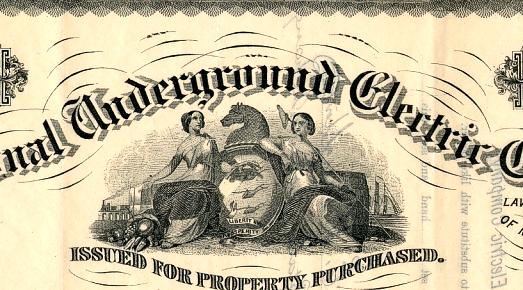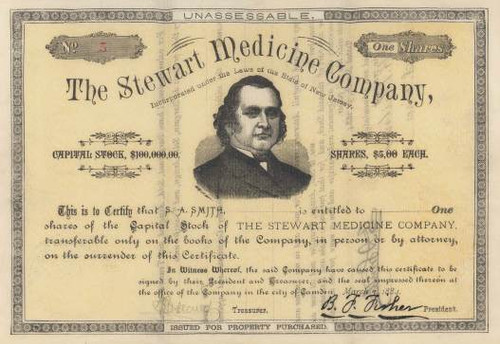Beautifully engraved certificate from the National Underground Electric Company issued no later than 1886. This historic document has an ornate border around it with a vignette of the New Jersey State Shield. This item is hand signed by the Company's Vice President and Secretary and is over 121 years old. There is also an embossed corporate seal with an image of a insulated cable that had 8 outside wires and one center wire, which may have been used for telephone and telegraph traffic. 
Certificate Vignette The National Underground Electric Company was incorporated under the laws of the State of New Jersey. Capital, $2,500,000, 500,000 shares, par value, $5.00; Office, 29 Market Street, Camden, N.J. Scientific American Supplement, No. 312, December 24, 1881, by Various SOLENOID UNDERGROUND WIRES IN PHILADELPHIA. The Evening Bulletin of the 29th October has the following: This afternoon a series of experiments were conducted at the Public Buildings which will be of great interest to electricians all over the country, and upon which the success of a number of underground telegraph projects in different parts of the United States depends. In all projects of this kind the problem which has given most trouble to inventors has been to overcome the induction. In other words, electric currents will leave their original conductors and pass to other conductors which may be near at hand. This interchange of currents may take place without seriously hindering ordinary telegraphy, as the indicators are not delicate enough to detect the induction. When telephones came into use, however, the induction became a great source of trouble to electricians, it often being the case that the sounds and influences from without were sufficient to drown out sounds in a telephone. To-day's experiment was conducted by Mr. J.F. Shorey, a well-known electrician, who exhibited Dr. Orazio Lugo's cables for electric light, telephone, and telegraphic purposes. A large number of prominent electricians were present, including the following: General J.H. Wilson, President of the N.Y. and N.E. Railroad, of Boston; Messrs. Frank L Pope, S.L.M Barlow, George B. Post, Charles G. Francklyn, Col. J.F. Casey, W.H. Bradford, and Selim R. Grant, of New York; James Gamble, General Manager of the Mutual Union Telegraph Co.; T.E. Cornich and W.D. Sargent, of the Bell Telegraph Co.; S.S. Garwood and J.E. Zeublen, of the Western Union, and others. The principal tests were made through the conduits on Market Street, laid by the National Underground Electric Company as far as Ninth Street. A cable of five conductors was laid through the conduit. Two of these conductors consisted of simple "circuit wires," while the other three were what is known as "solenoids." A solenoid wire is a single straight wire, connected at each end with and wound closely around by another insulated wire, this forming a complete system, the electric currents returning into themselves. Electricians claim that the solenoid effectually overcomes all induction, and this afternoon experiments were made for the purpose of proving that assertion. In the telephones, connected by the ordinary wires, a constant burr and click could be heard, that sound being the induction from the wires on the poles on Market Street, sixty feet overhead. With the solenoid the only sound in the telephones was the voices of the persons speaking. The faintest whispers could be heard distinctly, and the ease and comfort of conversation was in marked contrast to the other telephone on the ground wires. A set of telegraph indicators was also attached to the wires in use in the cable. The sounds were transferred from one "ground wire" to the other, while the solenoids seemed to resist every influence but that directed upon them by the operators. Another interesting test was made. The electric current for a Hauckhousen lamp was passed through a long coil of solenoid wire. Separated from this coil by a single newspaper, lay a coil of wire attached to telephones, yet not a sound could be heard in the telephones but the voices of the persons using them. The current of electricity created by a dynamo-electric machine is of necessity a violent one, and in the use of ordinary wires the induction would be so great that no other sounds could possibly be heard in the telephones. History from OldCompanyResearch.com.

Certificate Vignette













